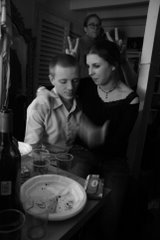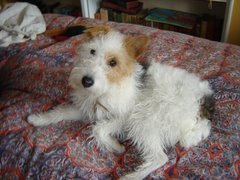Well the wine was really nice.
OK, so back to cussing Tunisia.
To be fair, everything that could go wrong did go wrong. In order: Air France was on strike, we got badly ripped off the second we arrived, the weather was catastrophic, we got the runs, the museum (that was dry unlike the rest of the country) was mostly shut...
You could argue the Air France strike was not Tunisia's fault, and that we got there in the end. You could argue that the weather was not Tunisia's fault either but it certainly didn't help.
We'd chosen Tunis, and more specifically its suburb Sidi Bou Said, a pittoresque cliff top village all painted in blue and white as a base to escape the onset of cold and grim weather in Europe. The plan was to relax in the North African autumn sun, going for beach side strolls and visiting the incredible Roman sites around the capital, more specifically Carthage which is part of Tunis and Dougga, the Tunisian Pompei which is about 150 km away.
The worst rain to hit the country ever put a bit of a damper on these (pun etc...). Though we realised at the time that it was bad, we later heard that people had died as the equivalent of 2 months rain fell in 2 days, putting severe pressure on the country's medieval infrastructure (exploding drains anyone?), flooding the city and generally causing a lot of damage.
We experienced this when, eager and rested after an easy afternoon wandering around and snoozing, we ventured off on the Sunday to Carthage, the suburb town just a few minutes train ride away and former capital of the Punic civilisation that occupied this part of Tunisia 2000 years ago before getting sacked and destroyed by the Romans.
We got the little train at Sidi bou said station, a few minutes walk down the steep hill on which the village is perched overlooking the marina. Less than a dinar (0,50 cents) for the two of us to get to Carthage, four or five stops down the line. When we got to there we realised that the rainwater was forming huge puddles every few feet by the side of the road and that making it anywhere with dry socks was going to be complicated.

We ended up cutting our losses and wading, and then set off in search of Carthage museum, one of the many sites we were going to visit that day. A good twenty minute walk up a hill, past huge designer houses with black window tinted Jeeps outside and we got to a huge soggy and flooded archaelogical site with an impressive 19th century mansion overlooking it. We spent a shivery hour in the Museum before we realised that we were coming down with pneumonia. Found a taxi outside who cheerfully announced that he would drive us back to Sidi but for a more expensive fee than usual as it was raining and we were clearly desperate. At least he was open about it.
The next day was crisper, cloudy but with the occasional sunbeam so we put on our dry clothes and set off back to Carthage. We started with the temple of Tophet, a site with three distinct layers of Punic and Roman remains, though we only ever really identified two. According to the Romans, the inhabitants of Carthage would sacrifice babies here, burning them in a kind of brick oven (which is still distinguishable) after slitting their throats. Ashes would then be put in clay jars stacked row upon row. Some historians argue that these sacrifices were actually stillborn or deceased children.
Saw some Punic columns with inscriptions and representations of Baal scattered around and hundreds of bits of broken clay pots crushed in the ground.
 These amphoras dating back two millenia are so common that they are ground up and used on tennis courts, or used by local fishermen to weigh down their nets. We saw dozens neatly stacked up on the site of the Punic war port, which is a perfectly circular harbour giving on to the sea,and is still used today by fishermen.
These amphoras dating back two millenia are so common that they are ground up and used on tennis courts, or used by local fishermen to weigh down their nets. We saw dozens neatly stacked up on the site of the Punic war port, which is a perfectly circular harbour giving on to the sea,and is still used today by fishermen.
As we settled down on a seaside terrace for a frugal lunch of fish and red wine, the storm rolled in from the jade couloured sea. It started slashing it down but we refused to be abashed, as at this rate we would have seen sweet piss all of anything; We trudged to another site, again of depressions in the earth, columns, wells and flashes of mosaic on the ground when the heavens opened. We took refuge in a hut with a couple of other glum tourists wearing T-shirts and flip flops. Feeling more confident in our anoraks, pullovers, umbrella and sensible shoes we decided to persevere and go to the Antonin Roman Baths, a huge site just down the road. We got there and went in to the vast area, which is like a Mediterranean garden with tombs and columns scatterd around, and the vast Bath buildings to the right. These are ruins but one can see the cathedral high columns which once supported the roof and make out the various bathing rooms and underground passages that carried the water, as well as the incredible drainage system (which failed to work that day). It was magical having the place just for us but as the water rose and we got wetter and wetter, the situation was pretty quickly ridiculous. We ignored the notices saying we couldn't climb on the ruins as it was the only way to stay above the waterline.

Once again, we cut our losses, and standing in the middle of the overflowing intersection got a cab home.
Our last day, we went to Bardo, a town just west and more or less adjacent to Tunis to see the renowned Bardo museum, home to many ancient mosaics. They are absolutely fabulous, covering scenes of feasting and myths and incredible sea creatures and allegories and scenes of everyday life.

We saw the later (Christian era) stuff, whichwas actually much less intricate, especially when it came to portraits. This is because early Christianity forbade depiction of allliving things- like Islam- and so portraits could only be done for tombs once the person was deceased which led to a lack of practice and loss of certain techniques.
We inquired how the mosaics got from the sites to the museum ( rip it up and reassemble jigsaw style?). It turns out that superstrong glue is poured on the mosaic, covered witha sheet of something, and the whole thing is ripped off. Kind of like waxing it would seem. It is then laid out on a new surface -concrete like the floors of the museum which are also covered in them, plaster like the walls- and the glue is dissolved off. .
We went into Tunis and walked around the Medina, having gone past the heavily barb-wired place Kasba around whichthere are a coupls of ministries and official government buildings. A tank was parked in the flower beds and there were soldiers with machine guns,but all around life rattled on. There were a lot of election posters of all the candidates (over 75) and some elderly women were yelling at soldiers. The medina is made up of zigzagging narrow streets, sometimes outside, sometimes under plastic sheeting , sometimes under a stone roof. There are shops, which become very dense as you hit the souk, but also little courtyards, artisan shops, houses, schools and a lot of people scurrying around in this maze dodging puddles with plastic bags on their heads.

That evening we made it to the airport in time to relax a little before boarding. saw several young men, severly wounded and either in leg casts or bandaged up in soggy looking cloth that dripped red. A plane from Tripoli had come in and we wondered if they came from there. Lots of Libyan flags and badges for sale. We had time for a final half bottle of lovely Nuit et Jour red wine, a fruity and peppery Shiraz, Cab sauv mix.
Also good as we found out as we spent fortunes in various restaurants for lack of anything better to do during our trip were the hearty Magon and Chateau Magon reds, but also the flowery Muscat white. It all goes perfectly with the best of Tunisian eating (once one has got past the excitement of briks, couscous and endless fresh fish served grilled), which are the nibbles one gets at the beginning of a meal. Little chunks of tuna in oil sitting on a mound of fiery harissa. Pickled sliced vegetables not unlike Korean kimchi. Little triangular goat cheese briks, carot sticks and chili and sliced boiled eggs. In one place we even got a palm sized whole fried fish.
Full of Tunisian red wine we hobbled back to Paris, actually feeling quite relieved to get home. It's put us off travelling for a bit, which is lucky cos we can't afford to go anywhere!



Aucun commentaire:
Enregistrer un commentaire